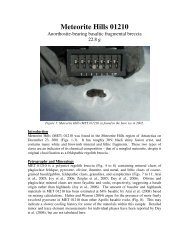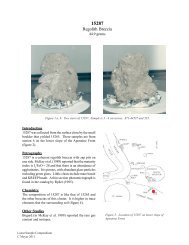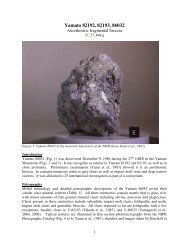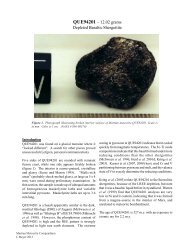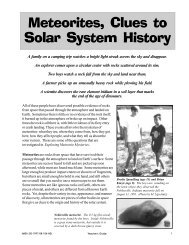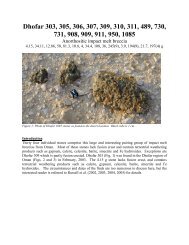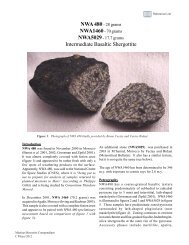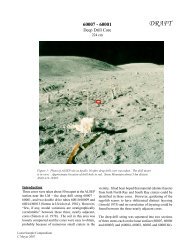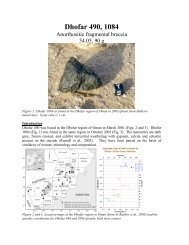Moore County Unbrecciated Cumulate Eucrite, 1.88 kg
Moore County Unbrecciated Cumulate Eucrite, 1.88 kg
Moore County Unbrecciated Cumulate Eucrite, 1.88 kg
Create successful ePaper yourself
Turn your PDF publications into a flip-book with our unique Google optimized e-Paper software.
the density of a Juvinas-like (or similarly eucritic) liquid would cause plagioclase to float rather<br />
than sink and accumulate (Stolper, 1977b). Experimental evidence suggests that the cumulate<br />
eucrites (including <strong>Moore</strong> <strong>County</strong>) may have indeed formed by plutonic fractional crystallization,<br />
but from a later, more ferroan liquid that first extensively crystallized magnesian diogenites and<br />
orthopyroxenites (Stolper, 1977a, 1977b). On the other hand, REE data do not necessarily agree<br />
with this contention (Ma and Schmitt, 1979), and a unique source region must be considered for<br />
the Stolper (1977a) hypothesis to hold (Ma and Schmitt, 1979).<br />
(3) <strong>Moore</strong> <strong>County</strong> trace element and REE abundances in pyroxene are higher than those observed<br />
for other cumulate eucrites (Pun and Papike, 1995; Pun et al, 1997). These may reflect an REEenriched<br />
(especially LREE) or closed-system parental melt (Stolper, 1977a; Ma et al, 1977; Ma<br />
and Schmitt, 1979; Pun and Papike, 1995; Pun et al, 1996; Hsu and Crozaz, 1997), but could also<br />
be due to increased Ca and Fe contents in pyroxene, allowing for greater REE accommodation<br />
(Pun and Papike, 1995). However, these abundance patterns can also be explained by subsolidus<br />
REE re-equilibration (Schnetzler and Philpotts, 1969; Pun and Papike, 1995; Treiman,<br />
1996a) or trapped melt fractions (see below), which would imply a “normal” eucritic source<br />
region (Pun and Papike, 1995; Treiman, 1996a, 1996b; Pun et al, 1997).<br />
(4) The most recent explanation for the variety of chemical anomalies in <strong>Moore</strong> <strong>County</strong> suggests<br />
the influence of trapped melt fractions in cumulate eucrites, as they can contribute significantly<br />
to trace element abundances and eliminate the need for a REE-enriched source region (Treiman,<br />
1996b; Pun and Papike, 1995; Pun et al, 1997; Treiman, 1997; Barrat et al, 2000). Newer models<br />
show that <strong>Moore</strong> <strong>County</strong> major and trace element abundances could be achieved from 37.5%<br />
cumulus pigeonite, 27.5% cumulus plagioclase, and ~35% main group or Nuevo Laredo eucritic<br />
melt (Treiman, 1996b; Treiman, 1997; Barrat, 2004).<br />
(5) The cumulate eucrites (e.g., Moama, Serra de Mage, <strong>Moore</strong> <strong>County</strong>, etc.) may have formed by a<br />
single fractional crystallization sequence (Hamet et al, 1978; Pun et al, 1996); if so, variable Eu<br />
data from these eucrites could indicate variable fO2 conditions for crystallization (Hamet et al,<br />
1978) or Eu 2+ /Eu 3+ buffering (Pun et al, 1996).<br />
(6) Partition coefficients for <strong>Moore</strong> <strong>County</strong> plagioclase and pyroxene have been determined by Ma<br />
et al (1977), Huebner and Nord (1981), Pun and Papike (1995), Hsu and Crozaz (1997), Treiman<br />
(1997), Pun et al (1997), Barrat et al (2000), and Barrat (2004).<br />
Cooling History: Much of the work on exsolution, decomposition, and inversion textures in <strong>Moore</strong><br />
<strong>County</strong> (see discussion in Mineral Chemistry) has been accompanied by investigations into the complex<br />
cooling history that produced these textures. Early workers, deriving conclusions from the limited state<br />
of igneous petrology at the time, suggested slow cooling followed by reheating to >1000 o C (Henderson<br />
and Davis, 1936) or a sudden and catastrophic removal of the meteorite from its source at a near-solidus<br />
temperature (~1135 o C: Hess and Henderson, 1949); both hypotheses were posited to explain the<br />
arrested inversion of pigeonite to orthopyroxene (i.e., no more than 30%: Nord, 1983).<br />
More detailed analyses of pyroxene exsolution lamellae suggest that the (001), coarser (≤100 µm) augite<br />
lamellae were produced at 8-9 km depth, with a cooling rate of 0.00016<br />
22<br />
o C/year, until the crystals cooled<br />
from 990-730 o C (Miyamoto and Takeda, 1977; Mori and Takeda, 1981b; Takeda et al, 1981; Miyamoto<br />
and Takeda, 1992; Miyamoto and Takeda, 1994). These crystals then experienced an early catastrophic<br />
removal (as in Henderson and Davis, 1936); the finer (001) augite lamellae and partial orthopyroxene<br />
inversion were produced by a later, more rapid cooling rate (0.3-0.48 o C/year) during a short reheating<br />
(≤940 o C) event at a depth of 100-150 meters, possibly in an ejecta blanket (Mori and Takeda, 1981b;<br />
Takeda et al, 1981; Miyamoto and Takeda, 1992; Miyamoto and Takeda, 1994). This later reheating




